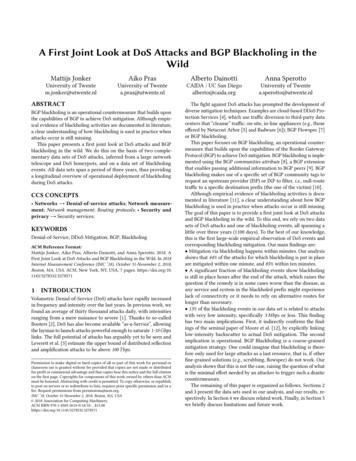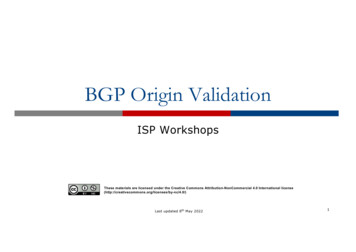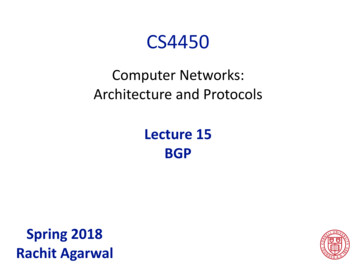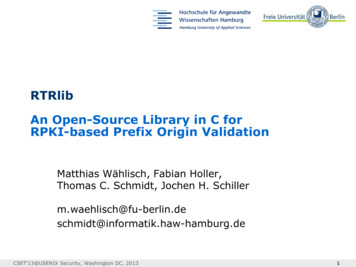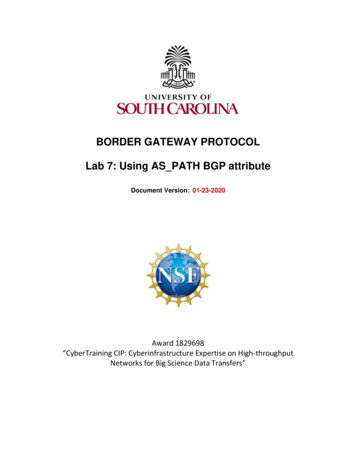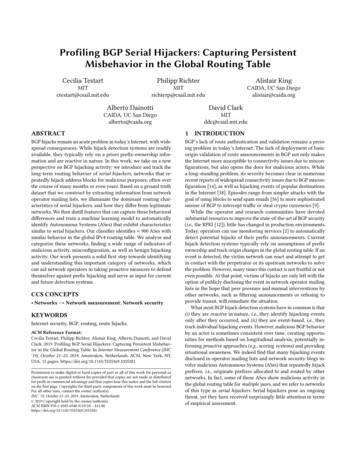
Transcription
Profiling BGP Serial Hijackers: Capturing PersistentMisbehavior in the Global Routing TableCecilia TestartPhilipp RichterAlistair .eduCAIDA, UC San Diegoalistair@caida.orgAlberto DainottiDavid ClarkCAIDA, UC San 1BGP hijacks remain an acute problem in today’s Internet, with widespread consequences. While hijack detection systems are readilyavailable, they typically rely on a priori prefix-ownership information and are reactive in nature. In this work, we take on a newperspective on BGP hijacking activity: we introduce and track thelong-term routing behavior of serial hijackers, networks that repeatedly hijack address blocks for malicious purposes, often overthe course of many months or even years. Based on a ground truthdataset that we construct by extracting information from networkoperator mailing lists, we illuminate the dominant routing characteristics of serial hijackers, and how they differ from legitimatenetworks. We then distill features that can capture these behavioraldifferences and train a machine learning model to automaticallyidentify Autonomous Systems (ASes) that exhibit characteristicssimilar to serial hijackers. Our classifier identifies 900 ASes withsimilar behavior in the global IPv4 routing table. We analyze andcategorize these networks, finding a wide range of indicators ofmalicious activity, misconfiguration, as well as benign hijackingactivity. Our work presents a solid first step towards identifyingand understanding this important category of networks, whichcan aid network operators in taking proactive measures to defendthemselves against prefix hijacking and serve as input for currentand future detection systems.BGP’s lack of route authentication and validation remains a pressing problem in today’s Internet. The lack of deployment of basicorigin validation of route announcements in BGP not only makesthe Internet more susceptible to connectivity issues due to misconfigurations, but also opens the door for malicious actors. Whilea long-standing problem, its severity becomes clear in numerousrecent reports of widespread connectivity issues due to BGP misconfiguration [14], as well as hijacking events of popular destinationsin the Internet [38]. Episodes range from simpler attacks with thegoal of using blocks to send spam emails [56] to more sophisticatedmisuse of BGP to intercept traffic or steal crypto currencies [9].While the operator and research communities have devotedsubstantial resources to improve the state-of-the-art of BGP security(i.e., the RPKI [12]), little has changed in production environments.Today, operators can use monitoring services [2] to automaticallydetect potential hijacks of their prefix announcements. Currenthijack detection systems typically rely on assumptions of prefixownership and track origin changes in the global routing table. If anevent is detected, the victim network can react and attempt to getin contact with the perpetrator or its upstream networks to solvethe problem. However, many times this contact is not fruitful or noteven possible. At that point, victims of hijacks are only left with theoption of publicly disclosing the event in network operator mailinglists in the hope that peer pressure and manual interventions byother networks, such as filtering announcements or refusing toprovide transit, will remediate the situation.What most BGP hijack detection systems have in common is that(i) they are reactive in nature, i.e., they identify hijacking eventsonly after they occurred, and (ii) they are event-based, i.e., theytrack individual hijacking events. However, malicious BGP behaviorby an actor is sometimes consistent over time, creating opportunities for methods based on longitudinal analysis, potentially informing proactive approaches (e.g., scoring systems) and providingsituational awareness. We indeed find that many hijacking eventsdisclosed in operator mailing lists and network security blogs involve malicious Autonomous Systems (ASes) that repeatedly hijackprefixes, i.e., originate prefixes allocated to and routed by othernetworks. In fact, some of these ASes show malicious activity inthe global routing table for multiple years, and we refer to networksof this type as serial hijackers. Serial hijackers pose an ongoingthreat, yet they have received surprisingly little attention in termsof empirical assessment.CCS CONCEPTS Networks Network measurement; Network security.KEYWORDSInternet security, BGP, routing, route hijacks.ACM Reference Format:Cecilia Testart, Philipp Richter, Alistair King, Alberto Dainotti, and DavidClark. 2019. Profiling BGP Serial Hijackers: Capturing Persistent Misbehavior in the Global Routing Table. In Internet Measurement Conference (IMC’19), October 21–23, 2019, Amsterdam, Netherlands. ACM, New York, NY,USA, 15 pages. https://doi.org/10.1145/3355369.3355581Permission to make digital or hard copies of part or all of this work for personal orclassroom use is granted without fee provided that copies are not made or distributedfor profit or commercial advantage and that copies bear this notice and the full citationon the first page. Copyrights for third-party components of this work must be honored.For all other uses, contact the owner/author(s).IMC ’19, October 21–23, 2019, Amsterdam, Netherlands 2019 Copyright held by the owner/author(s).ACM ISBN 978-1-4503-6948-0/19/10. . . UCTION
IMC ’19, October 21–23, 2019, Amsterdam, Netherlands We provide a detailed and longitudinal study of BGP announcement dynamics of serial hijacker ASes over the courseof 5 years. We develop hypotheses on prefix origination behavior (announcement stability, visibility, growth, addressspace fragmentation, origin conflicts) and identify dominantcharacteristics of serial hijackers and how they differ fromlegitimate ASes. We show that some of these behavioralpatterns are clearly visible when studying announcementdynamics of networks over long time periods. Based on these behavioral patterns, we propose a set of metrics and we use a machine-learning model to evaluate theirapplicability to the problem of automatically identifyingASes with BGP origination patterns similar to serial hijackers. Our classifier flags 900 ASes that exhibit characteristicssimilar to our ground truth serial hijackers. We provide a detailed analysis of these preliminary results, revealing insightinto false positives, actual malicious activity, as well as ASesappearing as illegitimately originating prefixes because ofthird-party misconfigurations. We illuminate behavioral patterns of serial hijackers in thewild with three case studies featuring a known serial hijacker,and two newly identified ones: a detailed analysis of multipleyears of hijacking activity by AS197426, a glaring case ofa serial hijacker from our ground truth dataset; AS19529, ahijacker network that was detected by our classifier, wherewe found corroborating evidence of hijacks; and AS134190,the network that, among the ASes we identify, shows themost recent indications of potential serial hijacker behavior.This work shows that, through analysis of readily available public BGP data—without leveraging blacklists or other indicators—itis possible to identify dominant patterns of serial hijackers. Ourpreliminary results suggest that these patterns can be leveraged inautomated applications, potentially revealing undetected behavioror generating a novel category of reputation scores. Our findingshave thus relevance for the operator community, since they can aidnetwork operators to identify suspicious ASes a priori, potentiallyallowing for preventive defense. Our findings are also of relevanceto the broader research community, since they provide viable input for new prefix hijacking detection systems, as well as for thedevelopment of AS reputation metrics and scoring systems.To the best of our knowledge, this is the first work focusing on thelong-term characteristics of this important category of networks,serial hijacker ASes. We make the feature dataset and the resultsof this work publicly available to allow both for reproducibilityand for other works to leverage our list of identified ASes.1 Whilethe majority of hijacker ASes only target the IPv4 space, we showmetrics both for IPv4 and IPv6.1 Auxiliarymaterial can be found at ique originated prefixes200150100500 201420152016201720182019date(a) Legitimate AS: Prefix origination of AS5400 (British Telecom) over the course of 5 years. This AS originates prefixesconsistently over long time periods.1200unique originated prefixesIn this paper, we provide a systematic empirical analysis of thebehavioral characteristics of serial hijacker ASes. We take on a newperspective on illicit BGP activity: instead of looking at individualBGP hijacking events, we study the long-term prefix advertisementdynamics in the global routing table in space and time. Our analysisleads to a set of key attributes that broadly capture the behavior ofserial hijacker ASes, highlighting several interesting and previouslyundocumented cases. Our main contributions are:Testart et al.10008006004002000 2016201720182019date(b) Serial Hijacker AS: Prefix origination of AS3266 (Bitcanal) over the course of almost 3 years. This AS announcesa large number of prefixes over short time periods.Figure 1: Long-term prefix announcement behavior for a regular AS, and a serial hijacker AS. We visualize each originated prefix as a row on the y-axis and color prefixes by theirnormalized visibility in the global routing table. We sort prefixes numerically and show time (3-5 years) on the y-axis.2BACKGROUNDTo bootstrap our analysis, we first introduce the serial hijackernetwork type, and illustrate some of its pertinent characteristicsby example. We review related work in the field of hijack detectionand network profiling, and present a roadmap for this paper.2.1Introducing Serial HijackersSince as of today, no reliable and widely deployed system to automatically discard illegitimate BGP route announcements exists,the network operator community frequently relies on mailing lists(e.g., NANOG [6]) to exchange information about illegitimate BGPannouncements and to coordinate efforts to limit their propagationand impact by blocking announcements from networks originatingsuch prefixes. The key observation that motivates this work camefrom studying 5 years of threads from operator mailing lists: many
Profiling BGP Serial Hijackersreported hijacks are not “one-off” events, where a previously unknown AS number starts to advertise prefixes. Instead, we oftenfind reports of the very same ASes repeatedly carrying out prefixhijacks. In fact, some of these networks continue to hijack differentprefixes over the course of multiple years. Figure 1b shows a visualization of the origination activity of AS3266, a network that wasrepeatedly reported to hijack address space. We see that, over thecourse of 3 years, this AS originated almost 1,200 unique prefixes,and we observe a highly irregular pattern of short-lived origination of disparate address blocks. To put this behavior in contrast,we show the origination activity of AS5400 (British Telecom) inFigure 1a. This network, a large British residential and mobile ISP,shows a much more steady pattern, longer prefix announcementtimes, and an overall constant, and monotonically increasing number of advertised prefixes. We note, however, that also legitimateASes can exhibit irregular patterns (see the white space betweenlines indicating a prefix was not originated at that time), often dueto configuration issues of the network in question or of third-partyASes. Thus, metrics and systems attempting to isolate ASes withpotentially malicious behavior must be chosen and evaluated carefully to allow for robustness. From Figure 1 it becomes clear thatthese two networks show wildly different long-term behavior inthe global routing table. The goal of this paper is to identify andscrutinize the dominant prefix origination characteristics of thisimportant class of networks: serial hijackers.IMC ’19, October 21–23, 2019, Amsterdam, Netherlandsserial hijackers. We focus exclusively on behavioral characteristicsrelated to their BGP origination patterns (i.e., we do not leverageany data other than BGP for our classification), and specificallystudy long-term behavior of networks.2.332.2Related WorkBGP vulnerabilities and hijacks have been studied for a long time[10, 13, 36, 37, 52]. However, proposals to secure BGP have notgained widespread traction. Even though the Internet EngineeringTask Force (IETF) standardized BGP prefix origin authorization andvalidation many years ago [29, 30, 47], deployment in productionnetworks is still limited [16, 18]. As a result, BGP hijacks are aprevalent threat and concern for network operators [48]. There havebeen many efforts in the research community to characterize BGPhijacking events [28, 56] and to develop hijack detection systemsusing different approaches, metrics, and vantage points [22, 27, 42,43, 46, 49, 50, 57]. While most systems focus on detecting individualBGP hijacking events, some attempt to identify the source of thecause and a few even tackle mitigation and remediation [7].In contrast to most earlier works on BGP hijacks, our approachworks by profiling the network-wide BGP prefix origination behavior of ASes. Few previous works study network-wide behavior ofmalicious actors. In [45], the authors study BGP announcementsdynamics of prefixes found in email spam blacklists. They findthat some spammers use short-lived (a few minutes long) BGProute announcements of large address blocks to send spam from IPaddresses scattered throughout the advertised prefix. In [51], theauthors study ASes that are over-represented in blacklists of phishing, scam, spam, malware and exploited hosts. Analyzing a monthof BGP data, they find that these ASes are more likely to becomeunreachable and that they have more changes in their connectivitythan most ASes in the Internet. Konte et al. [25] developed a systemto identify bulletproof hosting ASes, leveraging features such asfrequent re-wiring of transit interconnections. Our work is complementary in that we do focus on a specific group of malicious ASes,RoadmapThe rest of the paper is organized as follows: in § 3 we first describehow we build a ground-truth dataset of serial hijacker ASes, as wellas a control set of legitimate ASes. We also introduce our longitudinal dataset that covers 5 years of BGP activity at a 5-minute granularity. We introduce necessary data cleaning and preprocessingsteps in § 4. In § 5, we first introduce a set of behavioral characteristics and pose hypotheses on how the behavior of serial hijackerASes might differ from legitimate ASes. For each category, we introduce different metrics to capture AS behavior and study in detailhow serial hijackers’ BGP origination behavior differs from legitimate ASes in our ground-truth dataset and how our metrics capturethese differences. With our metrics in hand, in § 6 we proceed andtrain a machine-learning model to identify networks in the globalrouting table exhibiting similar behavior to serial hijacker ASes.In § 7, we present a broad and detailed study of the 900 networksflagged by our classifier “in the wild”. Finally, we feature three networks in case studies in § 8, and discuss implications and limitationsof our work as well as avenues for future work in § 9.DATASETSIn this section we first describe the datasets we leverage for identifying serial hijackers and a control group of legitimate ASes. Wethen introduce our longitudinal BGP dataset.3.1Legitimate ASes and Serial HijackersLegitimate ASes: We start our selection of legitimate ASes usingthe participants to the Mutually Agreed Norms for Routing Security (MANRS) initiative [5]. MANRS is a global initiative started bynetwork operators and supported by the Internet Society, whichproposes a set of actions, such as filtering and global validation ofInternet resources, that network operators can implement to fosterrouting security. Since MANRS participants voluntarily agree to implement a set of proactive security measures in BGP, it is unlikelythat they would repeatedly—and willingly—engage in repeatedBGP misbehavior or malicious activities. 272 ASes2 are part of theMANRS initiative. Additionally, we manually select 35 ASes thatrepresent the full spectrum of routed ASes: major end-user ISPs, enterprise networks, content/cloud providers, and academic networks.For these ASes, we are reasonably certain that the administratorsdo not willingly engage in repeated hostile activity.Serial Hijacker ASes: Finding ground truth on serial hijackerASes is a more difficult task: we process 5 years worth of emailthreads on the NANOG [6] mailing list and extract 23 AS numbersfor which network operators repeatedly disclosed hijacking events.We note that for each of these ASes the email threads includedseveral address blocks that had recently been (or were being) hijacked. Furthermore, in 4 cases, hijacker ASes were mentioned inconnection to hijacking events spanning multiple years.2 Laterin § 6 we only leverage MANRS ASes that have originated at least 10 prefixesin the 5 years considered in our study.
IMC ’19, October 21–23, 2019, Amsterdam, NetherlandsStart dateEnd dateSnapshot filesUnique prefixesUnique ASNsPrefix-origin pairsTestart et al.Jan 1, 2014 00:00:00 UTCDec 31, 2018 23:55:00 UTC525,8886,044,33376,7697,351,829Table 1: Dataset properties.Snapshot filesUnique prefixesUnique ASNsPrefix-origin 0196,13622,248196,137Table 2: Dataset properties after removal of incompletesnapshots and very low visibility prefix-origin pairs.In the remainder of this paper, we use the set of Legitimate ASesand Serial Hijacker ASes to first study the dominant characteristicsof serial hijackers in § 5, and to later train a classifier to identifythese characteristics in the larger AS population in § 6.3.2Longitudinal BGP DatasetWe base our study on snapshots taken from the global routing tablecomputed every 5 minutes over a time period of 5 years, leveraginghistorical BGP data from all available RIPE and RouteViews collectors. Starting on January 1st, 2014 and ending in December 31, 2018,we build an individual routing table for each peer (network thatfeeds into any of the collectors) of each collector every 5 minutesusing RIB dumps and BGP updates received over the respectivepeer-collector BGP sessions. For each of these routing tables, weextract prefix and origin AS numbers to generate 5 minute snapshots listing prefix-origin AS pairs (prefix-origins in the following)together with the count of peers observing them. Each snapshotfile contains between 560,000 and 1,240,000 prefix-origin pairs. Weobtain 288 files per day, 525,888 snapshot files in total. Across theentirety of our dataset covering 5 years, we find 7,370,019 uniqueprefix-origins to be advertised by at least one peer. We find a total of 76,769 unique ASes and 6,044,333 unique prefixes. Table 1summarizes the main properties of the dataset.4DATA PREPROCESSINGIn this section, we describe the necessary steps to de-noise ourdataset, and to convert individual snapshots into aggregated prefixorigin timelines for further analysis.4.1Dataset De-NoisingVariability of BGP peer availability: We leverage the count ofpeers that see and propagate an individual prefix-origin pair asa proxy for the prefix-origin visibility in the global routing table.Figure 2a shows the maximum visibility of IPv4 and IPv6 prefixorigin pairs in each snapshot file, i.e., the maximum number ofpeers that reported the same prefix-origin pair to any of the RIPEor RouteViews collectors. Over the course of 5 years, the maximumvisibility increases from the 250-300 range for IPv4 and 160-210range for IPv6 in 2014 to 400-500 (IPv4) and 300-400 (IPv6) in 2018,mainly a result of increasing participation of networks in the BGPcollection infrastructure. However, we see constant variability, e.g.,caused by lost BGP sessions between peers and collectors, or outages of individual collectors. Indeed, we find a number of episodesof significant reduction in the number of peers with active connections to collectors. During the 5 year period, the lowest maximumpeer count is 83 for IPv4 and 102 for IPv6. In order to reduce theimpact of significant peer disconnections and other BGP collectorinfrastructure problems, for IPv4 and IPv6, we do not consider asnapshot file if the maximum peer count drops below 20% of themedian maximum peer count of the previous week for the sameprotocol. In total, for the 5 year period, we ignore 1332 (for IPv4)and 1598 (for IPv6) snapshot files, representing 0.25% and 0.30% ofall available files respectively.Highly localized BGP advertisements: In every snapshot file,we find prefix-origin pairs with very low visibility. These BGPadvertisements can either be the result of highly localized trafficengineering efforts or related to misconfigurations and errors ofthe collector infrastructure itself or of a single, or a few, of theirconnected peers (recall that the total number of peers ranges between 300 and 500 for IPv4 during our measurement period). Weremove prefix-origin pairs that were seen by 5 or less peers. Whilewe specifically track both low-visibility and high-visibility prefixadvertisements in this work, these cases of very low visibility areunlikely to represent actual routing events of interest for this study.We find that, on average, of all prefix-origin pairs of a snapshot file,less than 20% of IPv4 and 15% of IPv6 prefix-origin pairs are seenby 5 or less peers, but point out that they represent only 0.09% ofIPv4 and 0.1% of IPv6 prefix-origins found in the routing tables ofBGP collectors’ peers at the time of the snapshot. Two thirds of thelow-visibility IPv4 prefix-origins are announcements more specificthan /24, and three quarters of IPv6 prefix-origins more specificthan /48. Table 2 summarizes the properties of the cleaned routingdataset for IPv4 and IPv6. We note that although filtering very lowvisibility prefix-origins reduces the overall number of prefix-originpairs from some 7.4M to 2.5M, it only represents 0.1% of all BGPcollectors’ peers routing table data during the time of the study.4.2Aggregating Snapshots to TimelinesOur methodology to go from individual snapshot files to a suitable data representation for longitudinal analysis of prefix-origincharacteristics consists of 3 steps:(i) Normalizing visibility: To deal with absolute changes in peercount when evaluating prefix-origin visibility, we normalize theraw prefix-origin peer count from each snapshot by dividing theabsolute visibility of a prefix-origin pair by the maximum peercount seen in each snapshot for the respective protocol (IPv4 orIPv6). Our normalized visibility thus is in the (0, 1] interval for eachprefix-origin pair.(ii) Building prefix-origin timelines: We next create timelinesfor each prefix-origin aggregating the 5-minutes-apart snapshotfiles, requiring (i) constant existence of the prefix-origin pair inconsecutive snapshot files,3 and (ii) a steady level of visibility ofthe prefix-origin pair. We find that prefix-origin visibility is overall3 Sincesome snapshot files are not considered due to low BGP peer availability (see§ 4.1), consecutive files can be more than 5 minutes apart.
Profiling BGP Serial HijackersIMC ’19, October 21–23, 2019, Amsterdam, Netherlands(a) Variability and growth of the maximum visibility (max. number of peers) inRouteViews and RIPE RIS combined.(b) Distribution of prefix-origin averagedmedian visibility. Most prefixes have either high ( 0.75) or low ( 0.15) visibility.(c) Prefix-origin total advertisement timefor different visibility levels for IPv4 andIPv6.Figure 2: Visibility of prefix-origin pairs in the global routing table.relatively stable, but we want to capture significant changes. Foreach prefix-origin timeline, we require that the visibility range(maximum visibility minus minimum visibility) of the prefix-originpair in all contained snapshots does not exceed 0.1, that is 10%.4(iii) Classifying prefix-origin pairs by visibility level: We nexttag each prefix-origin pair with its aggregated visibility, i.e., the median visibility of all contained timelines, weighted by their duration.Figure 2b shows a histogram of the visibility for all prefix-originpairs. Here, we observe a bi-modal behavior: for IPv4, 65.3% ofprefix-origin pairs show visibility greater than 0.75, while 26.1%show visibility lower than 0.25 (55.9% and 32.6% for IPv6 respectively). To better understand the relationship of prefix-origin visibility and the total time they are originated by an AS, we leverage thisbi-modal behavior of visibility and classify prefix-origins accordingto 3 levels of visibility as follows: Low visibility: prefix-origin pairs with an averaged medianvisibility of less than 15% of active peers. Medium visibility: prefix-origin pairs with an averaged median visibility of less than 75% but more than 15% of activepeers. High visibility: prefix-origin pairs with an averaged medianvisibility of 75% of active peers.Figure 2c shows the total time that prefix-origin pairs are visiblein the global routing table for high, mid and low visibility, for IPv4and IPv6. We note that, generally, high visibility prefix-origins arepresent in the global routing table for longer time periods whencompared to medium visibility prefix-origins, and low visibilityprefix-origins. Note that in Figure 2c, the maximum duration isnaturally constrained by our measurement window of 5 years.In the next section, we leverage our generated prefix-origintimelines from step (ii) and the visibility and total advertisementdistribution from step (iii) to compute features at the prefix-origin4 Wenote that for a single snapshot file, visibility of prefix-origins is strictly bi-modal,i.e., visibility is either close to 1 or close to 0. Our threshold of 0.1 thus works well tocapture significant changes.and AS level to scrutinize the prefix origination behavior of serialhijackers in the global routing table.5DOMINANT ORIGIN ASCHARACTERISTICSSince little is known about BGP behavior of serial hijacker ASesother than the anecdotal evidence that these networks are repeatedly involved in BGP hijacks, we start with a mental exercise ofdescribing how origination behavior of a network dedicated to malicious activity might look like in our BGP data. We identify fivemain characteristics: Intermittent AS presence: BGP activity of hijackers mightbe intermittent. We expect some serial hijackers to have offlineperiods, during which they do not originate any prefix and arethus not present in the global routing table. Volatile prefix origination behavior: We expect hijackersto show higher variability in terms of the number of originatedprefixes over time than legitimate ASes. Further, we expect serial hijackers to change prefixes more frequently, resulting in ahigher number of unique prefixes originated by serial hijackerswhen compared to the average number of originated prefixes. Short prefix origination duration: We expect that serial hijackers originate prefixes for shorter time periods than legitimate ASes. However, we also expect to see short-term origination of prefixes from legitimate ASes due to misconfigurations(cf. Figure 1a). We expect that different visibility levels of suchevents might help to disambiguate hijacks from misconfiguration events. Fragmentation of originated address space: We expect thatserial hijackers originate prefixes allocated to different RIRs(Regional Internet Registries), whereas most legitimate ASesoriginate prefixes allocated to a single RIR, reflecting geographicboundaries of ASes. Further, we expect that some serial hijackers originate unassigned address space.
IMC ’19, October 21–23, 2019, Amsterdam, Netherlands Multi-Origin conflicts (MOAS) of originated prefixes: Sincehijackers originate address space routed by other ASes, we expect to see a significantly higher share of MOAS conflicts forprefixes originated by hijackers, when compared to legitimateASes. We note, however, that there are also benign cases ofMOAS conflicts that are not indicative of hijacks. We take thebehavioral characteristics, i.e., duration and frequency, of MOASconflicts into account to disambiguate such cases.In the remainder of this section, we elaborate and test eachof these assumptions, introduce metrics that can capture thesebehavioral patterns, and contrast the behavior of our ground truthserial hijackers against our manually selected 35 legitimate ASes (cf.§ 3.1). We test the relevance of our metrics using the broader set ofground truth ASes in § 6 using a machine-learning classificationalgorithm. The features used to train the algorithm are based onthe properties described in this section.55.16A(a) Prefixes originated over time by a legitimate AS (AS7922).Inconsistency and Volatility of AS ActivityTo exemplify differences in AS activity, Figures 3a and 3b showthe number of originated IPv4 and IPv6 prefixes over time for alegitimate AS (AS7922, top), and a serial hijacker AS (AS133955,bottom). Here, we see a strong contrast: while the legitimate AS ispresent in the global routing table 100% of the time, we see that theserial hijacker AS showed activity in 2015, no activity in 2016, andthen again higher levels of activity starting in mid-2017. Althoughthe number of prefixes originated by both ASes varies over time,the legitimate AS shows an overall much more stable originationpattern. We note, however, that also legitimate ASes can show highlevels of short-term variability, as evidenced in Figure 3a. This peakis the result of AS7922 de-aggregating large prefixes for lo
perspective on illicit BGP activity: instead of looking at individual BGP hijacking events, we study the long-term prefix advertisement dynamics in the global routing table in space and time. Our analysis leads to a set of key attributes that broadly capture the behavior of serial hijacker ASes, highlighting several interesting and previously
